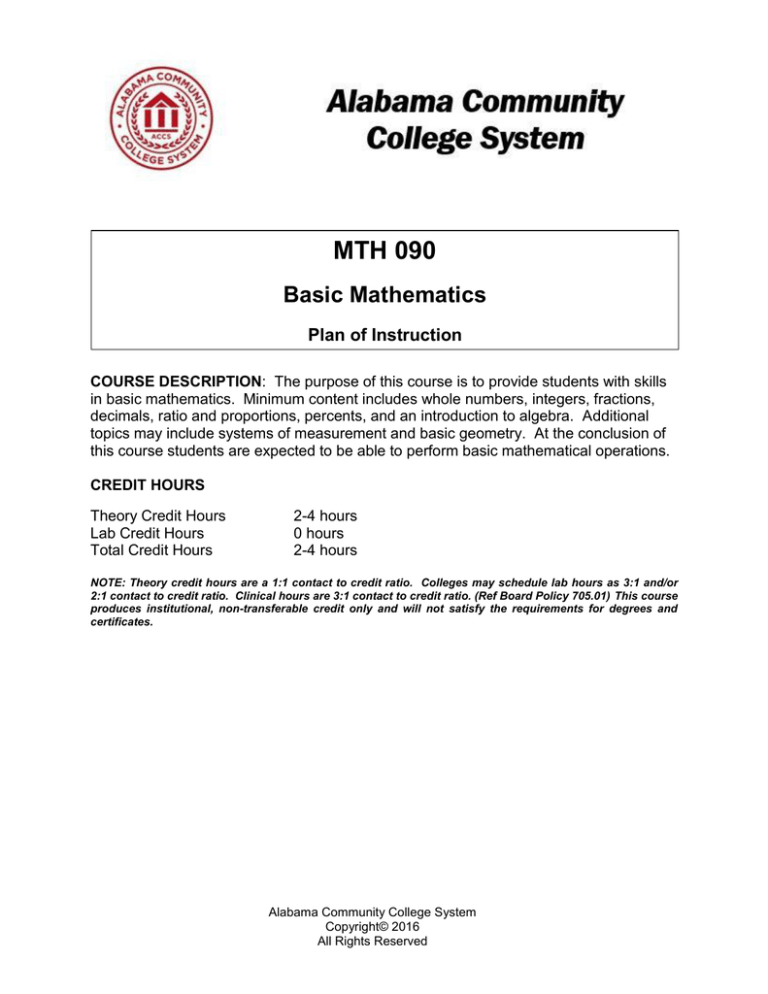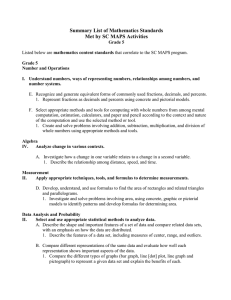
MTH 090
Basic Mathematics
Plan of Instruction
COURSE DESCRIPTION: The purpose of this course is to provide students with skills
in basic mathematics. Minimum content includes whole numbers, integers, fractions,
decimals, ratio and proportions, percents, and an introduction to algebra. Additional
topics may include systems of measurement and basic geometry. At the conclusion of
this course students are expected to be able to perform basic mathematical operations.
CREDIT HOURS
Theory Credit Hours
Lab Credit Hours
Total Credit Hours
2-4 hours
0 hours
2-4 hours
NOTE: Theory credit hours are a 1:1 contact to credit ratio. Colleges may schedule lab hours as 3:1 and/or
2:1 contact to credit ratio. Clinical hours are 3:1 contact to credit ratio. (Ref Board Policy 705.01) This course
produces institutional, non-transferable credit only and will not satisfy the requirements for degrees and
certificates.
Alabama Community College System
Copyright© 2016
All Rights Reserved
Basic Mathematics
MTH 090
PREREQUISITE COURSES
Appropriate mathematics placement score
CO-REQUISITE COURSES
As determined by college.
COMPETENCIES
Perform mathematical operations using whole numbers.
Perform mathematical operations using integers.
Perform mathematical operations using fractions.
Perform mathematical operations using decimals.
Apply ratio and proportion to problem solving.
Apply percents to problem solving.
Apply basic concepts of algebra.
INSTRUCTOR NOTE: Module H – Systems and Measurement and Module I –
Basic Geometry are optional modules. Instructors may teach these modules as they
determine to be appropriate.
INSTRUCTIONAL GOALS
Cognitive – Students will develop knowledge to perform various mathematical
operations.
Performance – There are no performance objectives directly associated with this
course.
Affective – There are no affective objectives directly associated with this course.
ACCS Copyright© 2016
All Rights Reserved
2
Basic Mathematics
MTH 090
STUDENT LEARNING OUTCOMES
MODULE A – WHOLE NUMBERS
COMPETENCY A1.0 - Perform mathematical operations using whole numbers.
LEARNING OBJECTIVES
A1.1 Define terms associated with whole numbers.
A1.2 Determine place value for a given digit.
A1.3 Round whole numbers to a given place value.
A1.4 Convert between standard notation and expanded notation.
A1.5 Perform basic mathematical operations.
A1.6 Convert between exponential notation and expanded form.
A1.7 Evaluate exponential expressions.
A1.8 Simplify expressions using order of operations.
A1.9 Calculate simple averages.
A1.10 Solve application problems using operations with whole numbers.
MODULE A TOPICS
Terms and definitions
Place value
Rounding
Standard notation
Basic operation
- Add
- Subtract
- Multiply
- Divide
- Estimations
Introduction to exponents
Order of operations
Averages
Applications
ACCS Copyright© 2016
All Rights Reserved
KSA
Indicators
1
2
2
2
2
2
2
2
2
3
3
Basic Mathematics
MTH 090
MODULE B – INTEGERS
COMPETENCY B1.0 – Perform mathematical operations using integers.
LEARNING OBJECTIVES
B1.1 Define terms associated with integers.
B1.2 Determine relative order of integers.
B1.3 Determine absolute value of integers.
B1.4 Perform mathematical operations using integers.
B1.5 Simplify expressions involving integers using order of operations.
B1.6 Solve application problems involving integers.
MODULE B TOPICS
Terms and definitions
Compare and order
Absolute value
Basic operations
Order of operations
Applications
KSA
Indicators
1
2
2
2
2
3
MODULE C - FRACTIONS
COMPETENCY C1.0 - Perform mathematical operations using fractions.
LEARNING OBJECTIVES
C1.1 Define terms associated with fractions.
C1.2 Express a composite number as the product of its prime factors.
C1.3 Determine the least common multiple of a set of numbers.
C1.4 Apply rules of divisibility to determine factors.
C1.5 Determine relative order of fractions.
C1.6 Reduce fractions to the simplest or lowest form.
C1.7 Convert between improper fractions and mixed numbers.
C1.8 Perform mathematical operations using fractions and mixed numbers.
C1.9 Simplify expressions involving fractions using order of operations.
C1.10 Solve application problems involving fractions.
MODULE C OUTLINE
Terms and definitions
Prime factorization
Multiples and divisibility
Compare and order
Simplifying
Mixed numbers
Basic operations
Order of operations
Applications
ACCS Copyright© 2016
All Rights Reserved
KSA
Indicators
1
2
2
2
2
2
2
2
2
3
4
Basic Mathematics
MTH 090
MODULE D - DECIMALS
COMPETENCY D1.0 - Perform mathematical operations using decimals.
LEARNING OBJECTIVES
D1.1 Define terms associated with decimals.
D1.2 Determine place value for a given digit.
D1.3 Determine relative order of decimals.
D1.4 Round a decimal to a given place value.
D1.5 Convert between fractions and decimals.
D1.6 Perform mathematical operations using decimals.
D1.7 Simplify expressions involving decimals using order of operations.
D1.8 Solve application problems involving decimals.
MODULE D TOPICS
Terms and definitions
Place value
Compare and order
Rounding
Converting fractions and decimals
Basic operations
Applications
KSA
Indicators
1
2
2
2
2
2
2
3
MODULE E – RATIO AND PROPORTION
COMPETENCY E1.0 - Apply ratio and proportion to problem solving.
LEARNING OBJECTIVES
E1.1 Define terms associated with ratio and proportion.
E1.2 Express ratios in various forms.
E1.3 Simplify ratios.
E1.4 Express the ratio of two different measures as a rate.
E1.5 Determine whether ratios form a proportion.
E1.6 Solve for the unknown in proportions.
E1.7 Solve application problems involving ratio and proportion.
MODULE E OUTLINE
Terms and definitions
Expressing ratios
Rates and unit fractions
Solving proportions
Applications
ACCS Copyright© 2016
All Rights Reserved
KSA
Indicators
1
2
2
2
2
2
3
5
Basic Mathematics
MTH 090
MODULE F – PERCENTS
COMPETENCY F1.0 – Apply percents to problem solving.
LEARNING OBJECTIVES
F1.1 Define terms associated with percents.
F1.2 Convert among fractions, decimals, and percents.
F1.3 Solve problems involving percents.
F1.4 Solve application problems involving percents.
MODULE F TOPICS
Terms and definitions
Converting among fractions, decimals, and percents
Solving problems involving percents
Applications
KSA
Indicators
1
2
2
3
MODULE G – INTRODUCTION TO ALGEBRA
COMPETENCY G1.0 – Apply basic concepts of algebra.
LEARNING OBJECTIVES
G1.1 Define terms associated with algebra.
G1.2 Evaluate variable expressions.
G1.3 Simplify variable expressions.
G1.4 Solve one step equations.
MODULE G TOPICS
Terms and definitions
Variable expressions
- Evaluate
- Simplify
One step equations
ACCS Copyright© 2016
All Rights Reserved
KSA
Indicators
1
2
2
3
6
Basic Mathematics
MTH 090
MODULE H – SYSTEMS OF MEASUREMENT
COMPETENCY H1.0 – Apply systems of measurement.
LEARNING OBJECTIVES
H1.1 Define terms associated with systems of measurement.
H1.2 Convert within customary system of measurement.
H1.3 Convert within metric system of measurement.
H1.4 Solve application problems involving systems of measurement.
MODULE H OUTLINE
Terms and definitions
- Customary
- Metric
Converting within systems
Applications
KSA
Indicators
1
2
2
3
MODULE I – BASIC GEOMETRY
COMPETENCY I1.0 – Apply basic concepts of geometry.
LEARNING OBJECTIVES
I1.1
Define terms associated with geometry.
I1.2
Find the area and perimeter of various geometric figures.
I1.3
Solve application problems involving geometry.
MODULE I OUTLINE
Terms and definitions
Area, perimeter, and circumference of geometric figures
- Parallelograms
- Triangles
- Circles
Applications
ACCS Copyright© 2016
All Rights Reserved
KSA
Indicators
1
2
3
7
Basic Mathematics
MTH 090
LEARNING OUTCOMES TABLE OF SPECIFICATIONS
The table below identifies the percentage of learning objectives for each module. Instructors should
develop sufficient numbers of test items at the appropriate level of evaluation.
Limited
Knowledge and
Proficiency
KSA
Module A
Module B
Module C
Module D
Module E
Module F
Module G
Module H
Module I
ACCS Copyright© 2016
All Rights Reserved
1
10%
17%
10%
12%
14%
25%
25%
25%
33%
Moderate
Knowledge
and
Proficiency
2
80%
66%
80%
75%
71%
50%
50%
50%
33%
Advanced
Knowledge
and
Proficiency
3
10%
17%
10%
12%
14%
25%
25%
25%
33%
Superior
Knowledge
and
Proficiency
4
8
Basic Mathematics
Indicator Key Terms
1
Limited
Knowledge
and
Proficiency
2
Moderate
Knowledge
and
Proficiency
3
Advanced
Knowledge
and
Proficiency
4
Superior
Knowledge
and
Proficiency
A
Affective
Objective
ACCS Copyright© 2016
All Rights Reserved
MTH 090
Learner’s Knowledge, Skills and Abilities
Description
Recognize basic information about the subject including terms
and nomenclature.
Students must demonstrate ability to recall information such as
facts, terminology or rules related to information previously
taught.
Performs simple parts of the competency. Student requires
close supervision when performing the competency.
Distinguish relationships between general principles and facts.
Adopts prescribed methodologies and concepts.
Students must demonstrate understanding of multiple facts
and principles and their relationships, and differentiate between
elements of information. Students state ideal sequence for
performing task.
Performs most parts of the competency with instructor
assistance as appropriate.
Examines conditions, findings, or other relevant data to select an
appropriate response.
The ability to determine why and when a particular response is
appropriate and predict anticipated outcomes.
Students demonstrate their ability to seek additional information
and incorporate new findings into the conclusion and justify their
answers.
Performs all parts of the competency without instructor
assistance.
Assessing conditions, findings, data, and relevant theory to
formulate appropriate responses and develop procedures for
situation resolution. Involves higher levels of cognitive
reasoning.
Requires students to formulate connections between relevant
ideas and observations.
Students apply judgments to the value of alternatives and select
the most appropriate response.
Can instruct others how to do the competency.
Performs competency quickly and accurately.
Describes learning objectives that emphasize a feeling tone, an
emotion, or a degree of acceptance or rejection.
Objectives vary from simple attention to selected phenomena to
complex but internally consistent qualities of character and
conscience.
Expressed as interests, attitudes, appreciations, values, and
emotional sets or biases.
9


